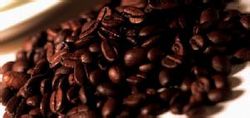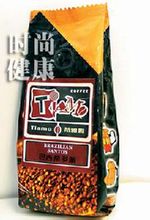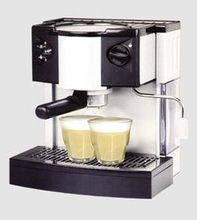Let's talk about Santos coffee.
Introduce editor Santos Coffee (Santos Coffee)
Mainly produced in Sao Paulo, Brazil. This kind of coffee acid, sweet and bitter is neutral, moderate concentration, with moderate sour taste, elegant and special taste, is the best blending beans, known as the strong coffee, but the taste is also good.

Santos Coffee Brazil is located in South America, about 15 degrees south latitude. Brazilian coffee culture began in 1727 and sprang up in the north of Brazil when a Mr. FrancescodeMelopalhata smuggled coffee seeds from France to Brazil. At that time, this was strongly opposed by the French who monopolize the coffee business today. Those seeds are the ancestors of more than 300 million Brazilian coffee trees today. In early Brazilian history, coffee started very slowly.
After Mr Palhta returned to Brazil, coffee culture began in the state of Bela, which is at the mouth of the Amazon. Coffee has a wide planting area and is the largest coffee exporter in the world.
But the famous "Santos" takes his name from the port where coffee is shipped, coffee in the valley around the capital, S ã o Paulo.
2 characteristic editor Santos coffee is mainly produced in Sao Paulo, Brazil. This kind of coffee is neutral in acid, sweet and bitter, moderate in concentration, moderately sour and elegant in taste.

Santos coffee is special, is the best blending beans, known as the backbone of coffee, single drink flavor is also good. Santos Coffee is pure and smooth, with high acidity and moderate silk, with a slight nutty flavor. 3 the name of the editor "Santos" comes from the port where the coffee is shipped. The coffee in the valley around the capital Sao Paulo is the most representative coffee in Brazil. Saint

Santos Coffee Doss is a neutral bean, the best flavor is known as the crown of coffee, if the preparation of other coffee has a unique flavor, the most suitable for people with aristocratic flavor, sense of humor and strong interpersonal relationships. The high-quality Brazilian Bourbon Santos coffee is comparable to Blue Mountain Coffee. If Blue Mountain is the king of coffee, then Brazilian Bourbon Santos Coffee is a hermit in the coffee kingdom. Like all Brazilian coffees, they are best served when they are fresh and tender, because the older they are, the more acidic they are. Although Brazil is known as the "kingdom of coffee", the hometown of coffee is not in Brazil, but in the Ethiopian province of Cafa in Africa. The name "Coffee" evolved from the place name of "Kafa". Coffee was introduced into Brazil after the 18th century. In 1727, Brazil had a border dispute with its northern neighbor French Guiana. In order to prevent the situation from spreading, the Brazilian Governor sent a delegation of military officer Francisco de Moro Barreta to French Guiana for negotiations in an attempt to resolve the dispute between the two countries by peaceful means. Unexpectedly, his border negotiations failed, but unexpectedly became the "father of coffee" of Brazil. French Guiana introduced coffee in 1722, first planted it in the backyard of the Government House, and then planted it on a small scale on a nearby farm. The Governor sees the coffee.

Italian espresso machine coffee is a "national treasure" for fear of being taken away by neighboring countries, especially Brazil, which was militarily and economically dominant at that time, so there are soldiers with guns patrolling around the coffee garden day and night.
After Moro Barretta arrived in Guyana, the coffee garden was heavily guarded and heavily guarded to keep Moro Barreta and his party from getting half a step closer. However, the handsome young officer won the favor of the governor's wife, not only invited Moro Barretta to taste coffee, but also personally accompanied him to visit the coffee garden, and presented a handful of ripe coffee beans and five coffee seedlings to Moro Barretta. After getting the seeds, Moro Barreta immediately left Guyana to escort the "national treasures" to Brazil. Since then, coffee has settled in Brazil. Those seeds are the ancestors of more than 3.9 billion Brazilian coffee trees today. In the early history of Brazil, coffee started very slowly. When Mr Molobaleta returned to Brazil, coffee culture began in the state of Para, at the mouth of the Amazon. About 1773, coffee was introduced from the north to Brazil's traditional agricultural areas on the southeast coast: Rio de Janeiro and Sao Paulo. As the climate here is very suitable for growing coffee, coupled with fertile land, cheap labor and other factors, coffee production in Brazil has developed rapidly. At the beginning of the 19th century, coffee was grown all over the country, followed by a "coffee boom" that lasted nearly a century.
4 taste editor taste Santos coffee, not only drink, but also smell.
Acidity (Acidity)
After the coffee is imported, the taste of leaving it on the tip of the tongue. The word "sour" looks eye-catching, but in fact, the original flavor and fresh vitality of coffee beans, like wine, are contained in its sour taste. The acidity of fresh coffee with the aroma of fruit, just like lemon, grape, apple and other fruits

The natural acidity of Santos coffee, which tastes pleasant and fresh, must be different from sour, another word used to describe expired and rotten coffee. The sour taste of Santos coffee is not strong, the taste is neutral and just right.
Texture (Body)
The sense of taste that lingers on the back of the tongue and mouth after sipping coffee. Santos coffee with mellow texture can bring strong taste shock even if the concentration of coffee powder is not high.
Aroma (Aroma)
Filled with the mellow aroma of Santos coffee walking in the air. From roasting, grinding to brewing, coffee beans try their best to release their fragrance at every stop of its long journey. Therefore, you might as well make good use of your sense of smell and experience this fragrant journey with Santos Coffee.
Flavor (Flavor)
Connect the above three to form a coffee impression. Santos Coffee is loved by many coffee lovers because of its moderate concentration and acidity, elegant taste, refreshing and harmonious flavor.
5 brewing method edits Santos coffee as a high-quality coffee variety, which can be drunk individually or mixed.
Single product production
Roasting: more and more people are fond of roasting their own coffee beans, because usually after the coffee beans are roasted, they can only keep their freshness for 1 to 7 days, and then they begin to stale, leaving only bitterness and no mellow taste. Therefore, self-baking can ensure the freshness of coffee beans.
The traditional roaster is drum-type, which has the characteristics of stewing, which will make the coffee beans more mature and full-bodied. The household drum roaster can bake half a pound of coffee beans at a time, and the baking time (including cooling and producing beans) takes about 210.25 minutes. If you want to roast deeply, you only need to increase the time. When in use, just put the raw beans, set the baking degree, press the start button, from baking to cooling, the roaster can automatically complete.
Grinding: in order to blend with water, coffee has made the greatest sacrifice-smashing into pieces. Before brewing coffee, the beans must be ground into fine grains to increase the contact area between water and coffee in order to extract the delicacy. In fact, the bean grinder is more important than the coffee machine. At present, most people choose the "sawtooth grinder" because it can grind uniform coffee powder quickly and steadily. The operation method of the sawtooth bean grinder is very simple, generally speaking, it will have two setting functions, one is to set the grinding degree, the other is to set the grinding time. The degree of grinding is mostly expressed in Arabic numerals, and the smaller the number is, the finer the grinding is. On the top of the bean grinder is a funnel shaped box containing unground beans, and below is a drawer to hold the ground coffee powder. When you choose to buy a bean grinder, you should pay attention to its power, usually between 70 watts and 150 watts, the higher the better, the higher the power, the faster the grinding speed, and the shorter time the coffee powder stays in the sawtooth, so it can grind the coffee powder at low temperature.
Brewing: to brew a good cup of coffee, you should not only have fresh coffee powder and slightly harder water, but also a set of easy-to-use brewing tools. There are three main types of coffee machines in common use.
Drip filter: wet the coffee powder with water and let the coffee liquid flow through the filter cloth or filter paper and flow into the container at the speed of natural fall. Basically, this method does not soak the coffee powder, just let the hot water pass slowly through the coffee powder. Both the drip cup and the electric coffee maker fall into this category and are the simplest brewing tools that can make clean and brightly colored coffee.
Bubble type: put the coffee powder into the pot, soak it in hot water for several minutes, and then filter out the coffee grounds by a filter cloth or screen to form a cup of coffee liquid.
Siphon pots, drip pots, Belgian coffee pots and Vietnamese coffee pots are all follicular brewing tools, and they all have a soaking process to form a more complex taste.
High-pressure type: use pressurized hot water to penetrate the compacted coffee powder to produce a thick cup of coffee in this form of tools such as a mocha pot and an espresso machine.
Quick brewing method: can use Italian espresso machine, faster coffee brewing method. The espresso machine can extract several cups of coffee successively. The oil and gum in the coffee beans can be emulsified and dissolved under high pressure during the brewing process, and the essence of the beans is completely extracted by pressure, making the brewed coffee stronger, better in taste and flavor.
Mixed preparation
First add deep-fried coffee to the cup, pour the same amount of milk into the milk pan, boil over low heat, add cream before foaming, do not wait for the foam to disappear and pour on the coffee.
6 Scientific drinking method Editor caffeine and coffee coffee is recognized as a healthy drink, but drinking coffee must be reasonable and scientific in order to be beneficial to health. Having a drink after getting up in the morning is a wake-up call. A light sip at work during the day can refresh you, and the coffee can be a little stronger. It is advisable to drink coffee slightly after dinner or in the evening. Both coffee and tea have refreshing effects, but they are not suitable for drinking during meals and should be drunk after meals. Some people like coffee very much, but they are afraid that drinking it often will get angry. There are some people just order coffee, this way of drinking coffee is not easy to be healthy. Should be served with a cup of white water when tasting coffee, this has two advantages: first, drink a mouthful of white water before tasting coffee, flush away the bad smell in the mouth, and then taste will feel mellow. Second, due to the diuretic function of coffee, drink more white water to improve urination and promote renal function. In this way, not only taste the delicious coffee, but also do not have to worry about getting angry, it is really killing two birds with one stone. When it comes to coffee, people will think of caffeine. Caffeine is a softer stimulant in coffee, which can improve the body's sensitivity, attention, metabolism, mental state and physical fitness. At present, caffeine has been found in about 60 plant species, of which tea and coffee are the best known. Coffee contains caffeine, and whether there is any response to caffeine varies from person to person. For example, some people are allergic to pollen, while others are not suitable for eating seafood. And these two situations will not have any effect on most people like you and me. How much coffee you drink every day is not too much. People often ask, how much coffee is too much? In some large coffee consuming countries, people consume an average of about 250 to 600 milligrams of caffeine a day. After repeated scientific research and analysis, this dose does not have any side effects on the human body.
7 related taboos editors suffer from high blood pressure, coronary heart disease, arteriosclerosis and other diseases-long-term or heavy consumption of coffee can cause cardiovascular disease. Older women-Coffee reduces calcium and causes osteoporosis. After menopause, women need to add ten times the amount of calcium every day. People with stomach problems-drinking too much coffee can worsen stomach problems. Pregnant women-drinking too much coffee can lead to fetal malformation or miscarriage. People with vitamin B1 deficiency-vitamin B1 can maintain the balance and stability of the nervous system, and coffee has a destructive effect on it. Cancer patients-drinking too much coffee is at risk of cancer to normal people.
Important Notice :
前街咖啡 FrontStreet Coffee has moved to new addredd:
FrontStreet Coffee Address: 315,Donghua East Road,GuangZhou
Tel:020 38364473
- Prev

Costa Rican Coffee
Costa Rican coffee is produced in The Republic of Costa Rica in southern Central America. Its coffee quality is similar to that of Colombia coffee, which is suitable for blending mixed coffee. Costa Rica's high latitudes produce coffee beans famous in the world, rich, mild taste, but extremely sour, coffee beans here are coffee beans after fine
- Next

Colombian coffee, one of the few individual coffees sold in the world under the name of the country.
Colombian coffee (Cafe de Colombia), which originated in Colombia, is one of the few individual coffees sold in the world under the name of the country. In terms of quality, it has won praise unmatched by other coffee. Compared with other producing countries, Colombia is more concerned with developing products and promoting production. It is this, coupled with its superior geographical and climatic conditions, that makes Columbus
Related
- Guji coffee producing area of Guji, Ethiopia: Humbela, Shakiso, Wulaga
- What is the most expensive variety of Qiloso in BOP multi-variety group?
- How to store the coffee beans bought home?
- Why are Yemeni coffee beans so rare now?
- Ethiopian Sidamo all Red Fruit Sun Sun Santa Vini Coffee beans
- SOE is mostly sour? What does it mean? Is it a single bean? what's the difference between it and Italian blending?
- Is Italian coffee beans suitable for making hand-brewed coffee?
- How to choose coffee beans when making cold coffee? What kind of coffee beans are suitable for making cold coffee?
- Just entered the pit to make coffee, what kind of coffee beans should be chosen?
- Can only Japan buy real Blue Mountain Coffee? What are authentic Jamaican Blue Mountain coffee beans?

